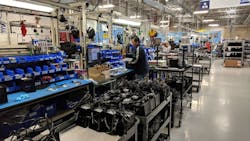Rob Gledhill is president of Blue-White Industries. He can be reached at 714/893-8529 or by e-mail at [email protected].
Although pumps date back to the ancient Greeks (100 BC)—powered by both animals and humans—they are still a bit misunderstood, particularly chemical feed pumps. I am going to share information I have picked up over the last 35 years working in the industry. My goal is to help you better understand the misunderstood "chemical feed pump." Listed below are also some common myths in the industry that I want to dispel.
Chemical Metering Pumps
"Chemical metering pumps should be trouble-free." Of course they should, and most are, until something in the installation or application, or both, negatively impacts the metering pump.
Of all your equipment, the chemical feeder will require more attention. The so-called "perfect chemical metering pump" will not perform well without some service. Left neglected is the beginning of a strained relationship.
Peristaltic vs. Diaphragm Pumps
"Which kind of pump is better, peristaltic, or diaphragm?" As a manufacturer of both I speak with some authority, and there is no definitive answer…really. It all depends on your specific job.
Peristaltic pumps are easier to prime for the novice, but if not maintained can be more trouble than diaphragm pumps.
As for diaphragm pumps, if you have a fair understanding of the basics of diaphragm pumps they tend to be more cost-efficient over a period of time.
Routine Improvement
"Do manufacturers build in planned obsolescence?" I believe I can speak for other metering pump manufacturers; the answer is an emphatic "no."
Nothing could be further from the truth. When we design a pump, countless destructive tests are run, and re-run repeatedly until it is right. Most of the time customers are not aware that pumps that are not new to the product line are routinely improved.
Chlorine
"Chlorine is on its way out." While alternative sanitizers are being developed, and some are in use, I don't see anything seriously challenging chlorine, now or down the road. This is a case where the good outweighs the not so good. Alternative forms of disinfectants will play a larger roll in our industry, but make no mistake, chlorine is overwhelmingly the disinfectant of choice.
Service Tips & Information
Below is some useful information and service tips on both diaphragm and peristaltic chemical feed pumps.
- Always wear eye protection. When working on a chemical metering pump, please protect your eyes. Your eyes are just too precious.
- Keep spare liquid ends. This is particularly true with diaphragm pumps. Most manufacturers have assembled pump-head kits. Don't be penny-wise and dollar-foolish in these areas. Most problems encountered are with fouled, disabled liquid ends (pump-head and valves).
- Keep variables to a minimum. This is a very important tip. With very sophisticated pumps, controllers and varying chemical strengths, as well as different conditions, keeping things straight is difficult at best. You can start by keeping the chemical straight; avoid varying the strength. The metering pump may have a speed controller and stroke adjustment. Adjust one or the other, not both unless absolutely necessary.
- Avoid running the chemical container dry. While your pump may not be mechanically harmed, pumping air (gases) will certainly dry out the residual chemical and gum up valves rather well, and time is money.
- Priming your chemical pump. Diaphragm chemical pumps do not prime well against line pressure. Wearing eye protection, either use a vent relief to help prime the pump, or if not available, disconnect the pressure side tubing and reconnect when the pump is primed.
- Diaphragm metering pumps. Please keep your suction tubing to a minimum (6 ft or less). The suction side is the weakest side. Imagine extending a straw to your beverage from 12 in. to 36 in. and trying to take a drink.
- Chemical compatibility. At some point of your career you have no doubt used a chemical without first checking if it is compatible with your pump. Take a few moments and do some research.
- No perfect set-up. Manufacturers do their best to provide materials to handle most chemicals, but there is not one perfect set-up that covers everything.
- Never inject chlorine and acid (pH adjustment) close to one another.
- Chemical feeder should run in concert with the system pump. Do not run chemical feed pump by itself unless your system is very specific for the feeder to operate alone.
- Flow indicator. A simple flow indicator installed on the suction line is a very useful diagnostic tool. A quick visual tells you the pump is operational.
- Installing a chemical feeder. Pin or nail the instruction and operating instruction booklet near the unit for a quick and easy reference.
- Injection fitting. Requires the most attention. Left neglected it will plug and damage your chemical feeder. Keep a replacement handy, clean and then rotate as needed.
- Warranty. Most all in-warranty problems are due to poor maintenance or improper installation.
- Worn roller assembly. If you are going through tubes quickly, your roller assembly may need replacing. Changing the pump tube will not solve the main problem. A worn roller assembly is difficult to see with a visual inspection. The inside diameter of the roller wears and the rollers eventually become out of tolerance. Change out the roller assembly.
- Peristaltic pump tubes. Please keep spare tubes handy for replacement. Change them regularly, you will know when because this changes from installation to installation and the conditions are different. Generally, 1,000 hours per pump tube.
Final Words
These are just a few tips I thought I'd share with you. Most manufacturers have websites with a wealth of technical information. In parting please remember the more informed you are the more success you will have with your often-misunderstood chemical feed pumps.


